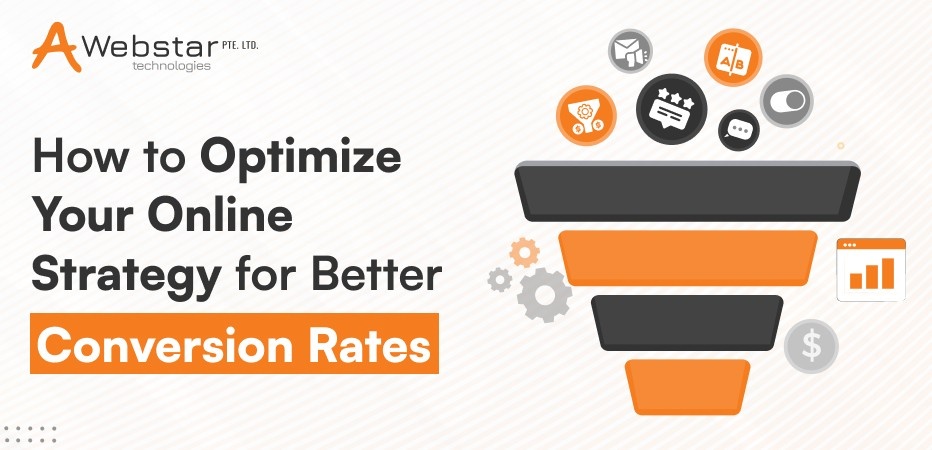
Optimising conversion rates is the key to attracting more visitors to take action on your site. These actions include purchasing, signing up, or clicking on a button. It helps your website run effectively, turning visitors into loyal customers. According to studies, businesses using A/B testing see a 49% improvement in their conversion rates.
Businesses focus on creating user-friendly websites with engaging content. It ensures that the pages load quickly so users don’t leave the site. A Digital Marketing Company helps businesses optimise those areas to get better results. Whether you want to improve your website design, personalise the user experience, or want to run ad campaigns. Making these small changes on your site can make a big difference in getting more users.
Read the blog and explore practical tips to optimise your online strategy for better conversion rates. By applying these strategies, you can ensure your site leads to meaningful interactions and better results for your business. Let’s get started!
How to Calculate Conversion Rates
Calculating your conversion rate is one of the most effective ways. It allows you to review how effectively the website performs. You can track how many users searched your website online and how much time they spent.
To calculate, you need to consider two key factors:
1. The number of people who took the action shows how many bought products or signed up for email on your site.
2. The number of people visiting your website: This shows the number of people who visited your site and their total time spent there.
Understanding Conversion Rate Metrics
To understand the metrics, you mainly need to know the formula. So, the formula is:
Conversion Rate =(Number of Actions/Number of Visitors)×100
For Example, 100 people visited your site. Out of those 100 people, five people make a purchase. For finding, divide 5 by 100, then multiply by 100.
So the math would look like this:
5/100 *100 =5%
That means 5% of the people who visited your site have decided to buy from your site.
A higher conversion rate means more users visit the website and become loyal customers. By adding useful information, you can make your website easier to use. Tracking your conversion rate helps you analyse user behaviour and make data-driven improvements.
Why Calculating Conversion Rates Is Important
Understanding your website’s performance is crucial for optimising your online strategy. Conversion rate tracking allows you to measure how many visitors take action, helping you identify what works well and what needs improvement.
A high conversion rate indicates that your website effectively engages visitors, leading to more actions—purchases, sign-ups, or inquiries. On the other hand, a low conversion rate suggests the need for enhancements, such as improving site speed, refining design, or optimising content for a better user experience.
By consistently monitoring and analysing conversion rates, businesses can make data-driven decisions. Testing different strategies and implementing best practices can lead to higher engagement and increased sales while saving time and resources.
Regularly optimising your online strategy ensures continuous improvement, turning visitors into loyal customers and driving long-term success.
15 Ways to Optimize Online Strategy for Better Conversion Rates
1. Implement A/B Testing
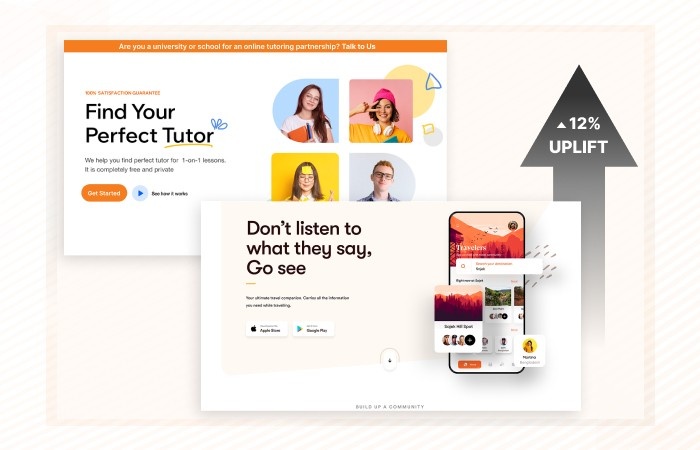
It helps you see which webpage version works better for your visitors. A/B lets you create two-page versions, making minor changes to a website, like different button colours or text. Then, you show both versions to visitors to see which version is most liked by the users.
After that, you compare the results to launch a website that users love. You can check whether your website attracts more users to take the actions you want them to, such as making a purchase or signing up for a newsletter. This helps you understand what works best for your website and users.
It is essential as it allows you to make data-driven decisions rather than guessing. By doing regular A/B testing, you can improve your website step by step and also improve the user experience. It helps you make more intelligent choices that lead to higher conversion rates.
2. Create a Compelling Value Proposition
A value proposition helps users to tell why they should choose your product or service. It explains the benefits, what makes your product unique, and how it meets user needs.
To make a strong value proposition, focus on the benefits of your product or service. Ensure it explains why people should use it and how it’s better than others.
Value proposition helps grab user attention and makes people want to learn more. It’s essential to keep it clear so visitors can easily understand why they should take action.
3. Optimise Your Conversion Funnel to Reduce Drop-Offs
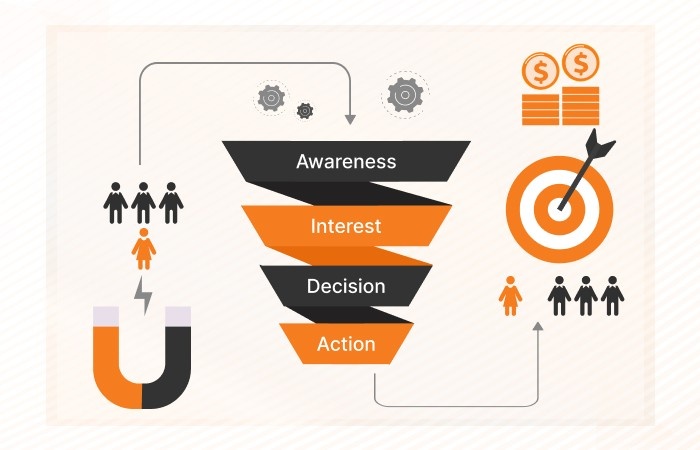
It shows the steps people take on your website before they complete an action. These actions include buying a product or signing up. It gives you a complete insight into how a user navigates your website and how many users purchased your products.
Checking your current conversion funnel is crucial to increasing the conversion rate. Check each process step, such as visiting your homepage, clicking a product, and adding it to the cart. Identify where most visitors leave without finishing.
Once you know where people stop, you can make changes to fix the problem. For example, you might simplify a form or make the checkout process faster. By assessing your funnel and improving weak points, you can help more visitors. It allows them to complete their journey and increases your conversion rates.
4. Make Your Site SEO-Friendly for Higher Conversion
Optimising your website is essential to making it SEO-friendly for users. It ensures that search engines can easily understand and rank your site on top. SEO services help improve your website’s visibility, making it easier for users to find your site when searching for relevant products or services.
Using relevant keywords in your page titles, headings, and content helps you match what users search for. Please make sure your website loads quickly, runs well on all devices and has straightforward navigation. This improves the user experience. Create high-quality content that answers questions or provides solutions that users may need.
An SEO-friendly website attracts more organic traffic. It increases the chances of users making purchases or signing up. Improving SEO can boost your online visibility and offer support for better conversion rates. These strategies make your online strategy more effective.
5. Build Trust with Reviews and Testimonials

It is crucial for gaining user confidence in your product or service. Reviews and testimonials are the most effective ways to gain trust. They reflect customer opinions and showcase the benefits of what you offer.
Positive reviews show that other customers had good experiences, which helps to reassure potential buyers. Satisfied customer testimonials highlight the advantages of your product or service.
Prominently displaying reviews and testimonials on your website increases their visibility. Adding real names, photos, or videos enhances their credibility.
Customers who trust your business are more likely to engage with it. This increases your conversion rates and helps your online strategy succeed.
6. Use Email Marketing Automation

It is a system that allows you to send emails to your audience without doing it manually. Email marketing helps you to stay connected with your users and enables them to take action. These actions include completing a purchase or signing up for services.
Automation means automatically sending emails based on specific events, such as new subscriptions or interactions with your website. These emails target relevant users and ensure the content is appropriate.
Automation can save you time and maintain consistent communication with your audience. It improves engagement by reaching users with the right message at the right time. This approach increases the chances of turning leads into customers, boosts conversion rates, and makes your online strategy more effective.
7. Add Live Chat Feature

Integrating a live chat feature into your website enhances customer support, increasing sales and retention. It enables customers to engage with real agents or AI-powered chatbots in real time, creating a seamless and efficient user experience.
Live chat is a powerful tool for instant assistance—answering product inquiries or resolving order issues. Partnering with a chatbot development company can help you implement advanced AI-driven solutions, offering immediate support that fosters trust, boosts customer confidence, and encourages conversions, such as purchasing or subscribing to a newsletter.
To maximize its effectiveness, position the live chat button prominently, such as in the corner of your website, ensuring easy accessibility. Live chat strengthens customer relationships and enhances satisfaction, ultimately driving higher conversion rates and a more successful online strategy.
8. Make CTA Buttons Stand out
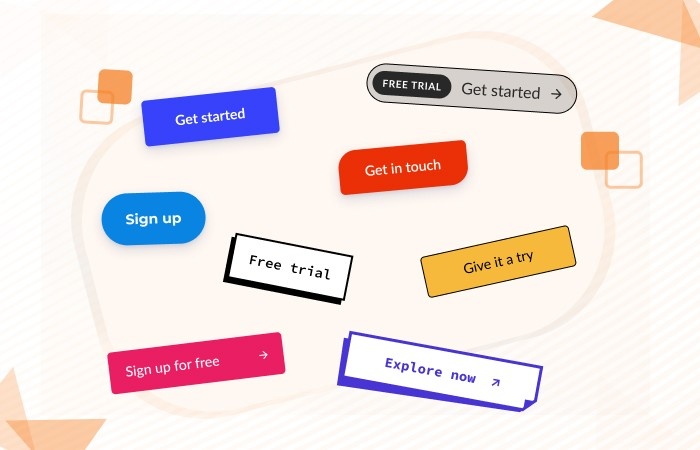
It is an essential part of your website that asks users to take action, such as “Buy Now” or “Sign Up.” These buttons stand out because they guide visitors to take the next step.
The importance of Call-to-Action (CTA) buttons lies in their ability to capture user attention and drive engagement. To make them noticeable, use bright colours that stand out. Place the buttons strategically—at the top of a page or near key information—so users can easily see and interact with them. Use clear, simple wording to ensure visitors instantly understand what action to take.
CTA buttons should be the proper size—not too small to miss or too big to distract. Users who easily find your CTA buttons are likelier to click on them. This improves conversion rates and makes your online strategy more effective.
9. Write Appealing Content
Writing appealing content is vital to keeping users engaged and enabling them to take action on your website. The content must be explicit and easy to read and explain how it can benefit users.
To make content appealing, focus on what your audience needs. Use simple and short sentences so users can easily understand. Underline your product’s benefits and explain why it’s the best choice. Add headlines, bullet points, and images to make your content enjoyable.
Avoid the use of long and tedious paragraphs. Keep the information informative and engaging. When your content grabs user’s attention and answers questions, they are more likely to trust you.
10. Remove Unnecessary Distractions
Removing unnecessary distractions from your website helps users focus on essential details. These distractions include ads, pop-ups, designs, and irrelevant content that distract users from your site.
To make your site user-friendly, keep the design simple and organised. Include information and features that guide users toward action. Avoid overcrowding pages with text, flashy animations, or links that lead users away from the site.
By removing distractions, visitors can easily navigate your site. This helps users find the information they need without getting confused, improving their experience and making them more likely to complete the desired action.
11. Optimise User Experience
It makes your website clear, simple, and easy for every user. A well-optimised webpage ensures that users can easily find the information they seek.
It helps you to improve the user experience. Ensure the website loads fast, has a fair layout, and is easy to navigate. Menus and buttons should be arranged appropriately so visitors can easily understand. It is also essential to ensure the website works smoothly on all devices.
Clear headings, readable fonts, and high-quality visuals improve the site’s look. A distraction-free and user-friendly website design helps users feel comfortable and confident. When the user experience is seamless, it increases the chance for users to take action.
- Related Content:-Why Business Owners Need to Focus on UX/UI Design Trends
12. Fix the Most Common CRO Issues
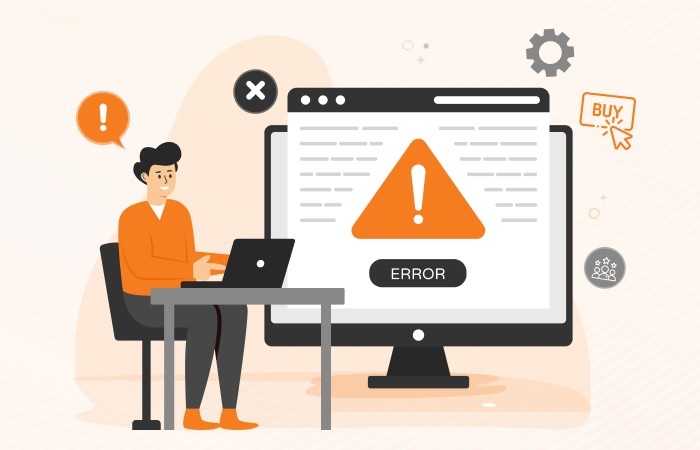
Fixing common CRO issues is key to improving how well your site turns users into customers. Addressing common CRO issues helps ensure a smoother user experience, leading to higher conversions. These issues make it hard for visitors to take action, such as signing up, buying, or contacting you.
Some common issues include slow-loading pages, confusing layouts, and hard-to-find buttons. To solve these issues, ensure your website loads quickly and has a simple design.
Another issue is forms that are too long and require too much information. Keep forms short and straightforward. Broken links or errors can discourage visitors, so regularly test your website. Fixing these issues creates a smoother user experience, boosts conversion rates, and improves your online strategy.
13. Use Concise Headlines with Bold Visuals
It helps grab users’ attention and makes your website easier to understand. A concise headline tells visitors about the page or why they should care. Bold visuals, like eye-catching images, make the message more engaging and memorable.
Clear headlines guide users by underlining the most important details. It helps visitors to decide what to do next, like learning more or clicking a button. Bold visuals make the page visually appealing when paired with these headlines. It keeps visitors interested in your site.
Avoid using clutter and long sentences in headlines. Instead, focus on simple words and designs that match the page’s purpose. Combining concise headlines with bold visuals will make your website easier to navigate. This improves user experience and increases the chances of visitors taking action.
14. Track Conversion Rate for Mobile Devices and Browser
It helps you understand how well your website performs across different platforms. Users use various devices as well as different browsers to visit your website. You might lose potential customers if your site doesn’t work well on one of them.
To improve conversions, you can check how many visitors complete their actions. Identify issues like slow loading times, broken layouts, or buttons that don’t work. Fixing these problems ensures a smooth user experience for everyone.
Regular tracking helps you spot trends and areas for improvement. It also ensures your site runs smoothly on all devices and browsers, improving the user experience. This increases the chance of users taking action and boosts your conversion rates.
15. Align the Landing Page with the Ad Copy
Aligning the landing page with the ad copy ensures that users see what they expect when they click on an ad. If an ad promises a discount, product, or service, the landing page must match that message. It helps you build trust and keeps visitors engaged and from leaving the page.
To create a strong connection, use the keywords, images, and offers from the ad on the landing page. The headline should be simple and related to what you mentioned in the ad. CTAs like Shop Now and Get Started should be easy to find and follow the promise made in the ad.
It improves the user experience and conversion rate. Users who quickly find the details are likelier to stay and engage on your site.
Conclusion
Optimising your online strategy ensures your website works well and attracts more users. When users visit your site, they should find it easy to use and helpful. Simple changes, like making CTA buttons clear, removing distractions, and adding live chat, can help users take action. A/B testing and tracking conversion rates allow you to understand what works best. Fixing common CRO issues ensures that users don’t leave your site frustrated. Keeping your landing page aligned with ad copy helps you build trust and keep visitors interested. With the above strategies, you can turn more visitors into loyal customers.
Want to improve your website’s conversion rate? Awebstar, a leading digital marketing company in Singapore, provides expert solutions to enhance your website’s performance. Our skilled team creates high-converting websites that engage visitors and turn them into loyal customers. Contact us today to get started! For more details on improving your conversion strategy, call +65 6909 9163 to speak with our experts.















































